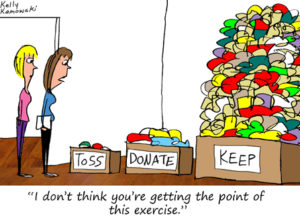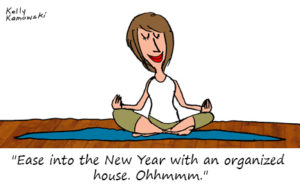Editor’s Note: In June we celebrate all things Dad, in celebration of Father’s Day. This month, I’m pleased to share this informative guide to garage organizing written by Trent Skousen, from Golden Gate Garage Storage, a colleague and associate member of the local chapter of my professional association, NAPO (National Association of Organizing and Productivity Professionals). Trent and I share a lot of the same ideas about garage organizing. Read on and make this Summer the one you finally get your garage organized!
When I was a kid, my mom would task the family with giant cleaning days. They were usually before family or friends came to visit, although I suspect some days, she just got the itch to clean up. We would spend all day sorting through the living room, bedrooms, and kitchen to make everything look nice and orderly.
Part of that organizing was removing the clutter from most of the house. Unfortunately, we just dumped most of that extra stuff in the garage. Have too many toys in the bedroom? Throw some in a box in the garage. Too many cleaning supplies under the bathroom sink? Put ‘em in the garage. We did that over and over.
As a result, the garage became so cluttered and packed over time, we couldn’t even park our cars in there. It became so cramped that we lost all motivation to get it organized. The whole project was overwhelming. Finally, my dad persuaded (bribed) my brother and me to take a week of our summer vacation to go in there and sort everything out.
Many homeowners experience something similar happening in their own garages. These spaces look more like an old warehouse than a functional home space. It becomes a dumping ground for everything we don’t want to deal with in the house. How do we end this vicious cycle? With a little conscious effort, an organized and functional garage isn’t as far-fetched as it sounds.
With Father’s Day around the corner, now is a great time to take a look at getting that garage fixed up for Dad. Here is your ultimate survival guide to get you started.
Step 1- Develop a game plan:
Benjamin Franklin said, “By failing to prepare, you are preparing to fail.” Planning in organization is just as important as doing the organizing itself. Not only does planning give you an idea of what you need to accomplish, it gives you the peace of mind of knowing what you need to do exactly when you need to do it.
Sit down with your team. This can be your family, friends, or organizing professionals. Set a realistic goal that you can shoot for. One example could be to leave nothing left on the garage floor by the time you finish.
After you have your goal, here are some tips about things to include in your plan:
- Pick a date- You need to get a specific date in mind to start and stick to it. Write it out and tell your family. Make sure that you are set on getting to work and won’t have anything to distract you. Give yourself a reasonable amount of time to complete it. Don’t plan to finish it in a day if you need several weekends.
- Plan on who will be helping- How many people will be there to help? How much can each person handle? Are there any children helping that need simpler jobs?
- Figure out costs- If you’re planning on hiring help or buying equipment, you’ll need to set a budget and determine costs ahead of time. Be sure to weigh the cost against the benefit for each item – sometimes paying a little more will save you time, money, and stress in the long run.
Step 2- Cleaning:
Move all of the items in the garage out to the driveway, lawn, or backyard. You won’t be able to do a deep clean without emptying the space first. If you have limited space or weather issues, consider focusing on smaller portions of the garage at a time.
As you move your possessions, it helps to sort them into piles based on their function (i.e. camping gear, gardening equipment, power tools, etc.).
With the empty space, deep clean the garage surfaces, walls, and floors. Start from the ceiling and move toward the floor, so you don’t get things dirty that you already cleaned:
- Replace any dead light bulbs.
- Dust off shelves and cabinets.
- Wipe down any tables or workbenches.
- Scrub the walls and floorboards to remove scuff marks and blemishes.
- Sweep and mop the floor.
Having a clean garage will not only make it look nicer, but also make it safer to breathe the air and touch the surfaces inside.
Step 3- Decluttering:
*Note: This step is interchangeable with Step 2. You can do this before, after, or during the cleaning phase. Do what is best for your situation.
Now, you’ll want to start getting rid of anything you don’t need in order to create more space.
Start by systematically going through everything individually. Like I mentioned, it helps to group things together by category (like chemicals, tools, stored personal items), and decide what you still need and what you don’t. If things are broken, old, or you don’t use them anymore, get rid of them first.
After that, take what remains and make a second pass at them. This can be trickier, because now you really have to think about the item and the likelihood you will use in the near future. Like Lis McKinley, Certified Professional Organizer and owner of LET’S MAKE ROOM always says, “Just because something is useable, doesn’t mean you have to keep it! Almost everything is useable. When you need space, the goal should be looking for reasons to let it go, not finding reasons to keep it.”
If there are items of sentimental value, ask yourselves if you really are happier having it around or if you’ll use it. If not, it’s time to let it go.
“Be realistic about what you keep in the garage,” she adds. “It should be things you actually use, such as tools, or things used seasonally such as sports equipment or holiday supplies – but even these things can be curated. Stick with the notion of, do I use it now? Am I likely to use it this year? Would I miss it if it disappeared? If not, give it away where it can be used and appreciated.”
Step 4- Reorganize:
At this point, you should have your essential items and a clean garage. It’s time to organize your items in the garage.
Consider using a zoning strategy. Zoning means to group similar items together in storage. This helps you know where everything is and helps you keep track of what you have and makes it easier to find what you need in the future. If you already grouped items together during decluttering, this shouldn’t be too hard.
Another suggestion is to consider using storage systems. This can be as simple as stackable bins, hooks on the wall, and baskets. Other options that really reduce the clutter include shelves, cabinets, and overhead storage racks. Storage systems help get everything off the ground safely. This is especially useful if you have young kids wandering through the area, because you can keep dangerous chemicals or tools hidden out of reach. Plus, it gives you more space to park your car or even include things like workbenches or workout equipment.
Step 5- Continue the process:
Just because your garage is clean and organized doesn’t mean it will stay that way without help. Plan time each week to tidy up, just as you would with the rest of your house. Sweep out debris and make sure things are off the ground and in their proper place. If you buy something new that needs a place, take a few minutes to rearrange everything so that it has a proper place of its own.
Having a nice garage will make your home more functional and enjoyable. With a little planning, organizing can be a fun and rewarding process!
This post was written by Trent Skousen at Golden Gate Garage Storage. He enjoys going to movies and watching basketball with his wife.











